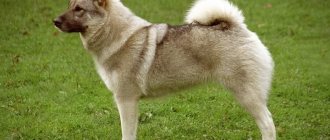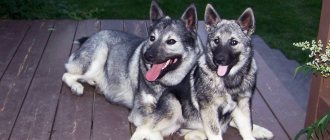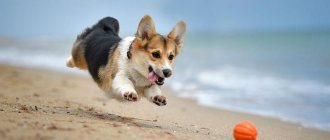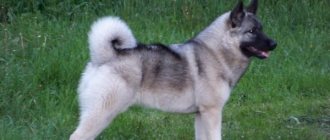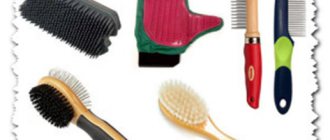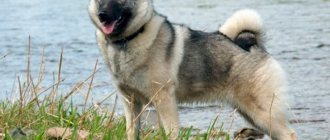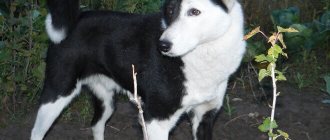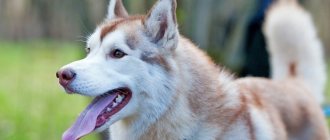Care and maintenance
The best habitat for both black and gray moose huskies is a country house with a large plot.
Animals are accustomed to living in freedom, and limited space greatly oppresses them. If a person nevertheless decides to have an Elkhound in an apartment, he will have to devote at least three hours a day to active walks. The elk husky should have a kennel in the yard where it can shelter from bad weather. It is prohibited to keep freedom-loving animals on a chain. This approach is fraught with mental disorders, the emergence of unmotivated aggression and distrust of people.
The right diet
The Norwegian elk husky is not a picky eater and does not have any particular taste preferences. The diet of both gray and black elkhund can consist of ready-made food or natural food.
In the first case, pets are bought high-quality premium, super-premium or holistic products. Cheap food contains artificial additives and ballast substances, and therefore inevitably leads to health problems.
Many breeders believe that natural nutrition is preferable for primitive breeds. Then moose huskies are given lean meat (beef, rabbit, chicken and turkey) and offal - they account for 40–50% of the total food. The rest of the diet is formed from:
- rice, buckwheat and millet porridges;
- fermented milk products;
- vegetables and fresh herbs.
Once a week, Norwegian elk huskies are given sea fish and chicken eggs. In winter, when animals require more energy, the amount of protein food is increased.
Walking and physical activity
Even if kept outdoors, a moose husky must be taken outside twice a day. The duration of exercise should be at least 1 hour. The dog will be happy to go into nature - to the forest or to the shore of a reservoir. She will happily accompany her owner on a jog, bike ride or hike.
Training and education
The Norwegian Elk Husky is intelligent, but can be quite difficult to train. This is due to independence and willfulness - the pet will not blindly follow commands. In order to raise a manageable and obedient animal, training begins immediately after the puppy appears in the house.
The baby is not touched for a couple of days so that he gets used to the new environment and gets to know the owner.
After this he is taught:
- come when called;
- wear a collar and leash;
- observe standards of behavior and not violate prohibitions;
- sleep on a couch.
When the vaccination quarantine ends, the Norwegian elk husky is taken outside and actively socialized. The dog should not be afraid of city noise, strangers and unfamiliar animals. More and more busy streets are chosen for walks, constantly changing routes so that the pet gets a complete picture of the world around him.
On walks and during games, the Norwegian elk husky learns the commands “Come to me!”, “You can’t!”, “Ugh!”, “Place!”. At 3–4 months, she is taught to sit and lie down on command, and to walk next to her owner on a loose leash. Over time, the lessons become more complicated, supplementing orders with gestures and endurance training.
You need to talk to the puppy more in a friendly tone. If the pet is stubborn, the intonation is changed to strict, and they achieve what they want without the use of violence. The child is sincerely praised for correct actions. Treats provide additional motivation. And although the Norwegian Laika is a hunting breed, it will be useful for it to undergo OKD.
Dogs that are planned to be used for hunting begin to be trained in the field at six months. It is better to do this in the company of experienced dogs, since the Norwegian Elk Husky has a developed imitative instinct. Trained puppies become good hunters at 8–10 months.
Care and hygiene
Black and gray moose huskies require minimal hygiene. Coat care comes down to weekly brushing. During the molting period, the fur is treated with a slicker every 2-3 days.
The Norwegian moose dog is quite clean - it will not step in puddles, roll in the mud or dig through garbage. Its coat is capable of self-cleaning, so bathing is required in exceptional cases.
Ears are cleaned once a week, eyes are wiped with an antibacterial solution when discharge appears. The claws are trimmed as they grow, if the Norwegian elk husky does not grind them down on his own. To maintain dental health, she is given large bones or dental treats to chew on.
Some dog breeders clean the dog with a special brush and veterinary paste about once a week.
What to feed?
A good diet is considered the foundation for good health and lifestyle. To protect your Norwegian Husky against allergies, it is worth remembering that you should not let him eat from your own table. Prohibited foods include the following:
- Sausages and smoked products;
- Salty and spicy dishes;
- Sweets and in particular chocolate;
- small bones;
- bakery;
- pasta.
Meat and meat products must be served to the dog in a prepared form that ensures that they do not contain dangerous microorganisms. Raw vegetables and fruits should be washed well before serving to the dog. You can also feed your dog grains such as buckwheat and rice. On the Norwegian diet, saltwater fish, dairy products, eggs, vegetable fats, by-products and herbs should be found.
When you decide to serve dry food, you should only buy premium products with a good use-by date.
Nutritional Features
The Norwegian Husky is one of the most selected genera of hunting dogs. This is due to the Elhen lifestyle pattern, in the form of centuries characterized by continuous dietary restriction. But this does not mean that a dog's diet should be frugal and primitive: persistent poor nutrition has a negative impact on the animal's health, performance and appearance. It is up to the dog owner to decide which type of food - natural or prepared - is preferable, depending on his capabilities.
If you choose dry karma as your main diet, it should not be lower than Premium. The best choice for regular nutrition is Karma Karma Super Premium and Holistic, which takes into account the age and physiological state of the dog as a whole. They do not contain any synthetic ingredients and are formulated with vitamin-mineral supplements in addition to essential nutrients that are consistent in quality and quantity.
The debate about whether to feed dogs commercial food or not has been going on for years. In any case, after considering all the pros and cons, only the pet owner makes the choice. You can read more about how to attract a dog to dry up karma in our separate article.
Experienced breeders believe that natural nutrition is preferable for working breed dogs. In this case, the basis for the daily dose of an adult animal is the animal posture:
- protein - 400 g;
- Complex carbohydrates - 350 g;
- Animal fat - 15 g;
- Fiber - 150-200 grams.
Please note that the content of ingredients must be adjusted depending on the season:
Norwegian Husky in winter
- In winter, to compensate for the increased energy demand, the proportion of protein increases and the amount of fiber decreases;
- In the summer, when appetite decreases, more sources of fiber are added to the dog’s menu - vegetables, berries, fruits.
A fragment of all karma for Elhun is recommended: in this way, the food is digested faster and better, and the dog can be active almost immediately after eating. The volume of one piece should generally not exceed 3% of the body weight of the PSA.
This average amount of food increases by about 1/3 when we go hunting. To develop animal husbandry, normal feeding behavior is used, feeding regulation is used: adult Norwegian Huskies, usually twice a day. Regardless of the type of diet chosen, the dog should always have access to clean water.
Norwegian Lundehund: photo, description of the breed
1402
Article rating
The Norwegian Lundehund, also known as the Norwegian Puffin Husky, is the oldest breed of dog from Norway. Today there are only a few of them preserved on the northwestern Norwegian coast, which became the founders for the preservation and reproduction of the breed.
Norwegian Lundehund
The uniqueness of Norwegian dogs
Norwegian Lundehund dogs appeared in the 16th century from dwarf representatives of elk breeds with the purpose of helping in hunting mountain partridges. During the night alone, skilled lundehunds caught up to 80 birds and, with due care, carried partridge eggs in their teeth, which were valued by local residents. Lunde is the name of those birds in Norwegian, from which the name of the breed comes.
The Norwegian Lundehund is unique not only as a hunter. It differs from other representatives in appearance and acrobatic capabilities. These dogs are very flexible, capable of touching their back with their nose and throwing their head back. Naturally able to navigate narrow paths and mountain crevices, the Lundehund tends to spread its front paws wide to the sides, just as a person spreads his arms. The Norwegian hunter knows how to fold his always erect ears so that the ear canals are closed, preventing the penetration of foreign objects, dust and water. In addition, Lundehunds have extra toes on all four paws to help them climb rocks.
Lundehund Appearance Standard
Males of the Norwegian Lundehund reach a height of up to 35-38 cm and weigh up to 7 kg, females are slightly lower and a little lighter, from 32 to 35 cm and up to 6 kg.
General physique
The photo of the dog shows that its body is slightly stretched, but built firmly. The oval-shaped paws are slightly turned outward. One of the distinguishing features of the breed is six-toed dogs. The back is straight in line with a sloping croup. The chest is located quite deep in front between the paws. The tail is of medium length, covered with thick hair and set high, wrapped in a ring shape, extending to the line of the back, and can hang freely.
Head
It has triangle proportions and medium-sized width, the transition from the frontal bone to the muzzle is quite clearly visible, the forehead is slightly convex. The parietal part is longer than the muzzle, which is quite noticeable. The color of the iris is dark brown or yellow brown. The eyes are slightly slanted. The ears are triangular in shape, wide at the base and medium in size. Located in a standing position, movable.
Color
The coat is thick and dense, only on the head and paws it is short and smooth. There is a soft undercoat.
The breed standard allows red-brown and yellow-brown shades of coat, but the presence of white is a prerequisite. You can often find black tips. The color can also be gray or white, diluted with dark spots.
The character of the Norwegians
Norwegian hunters are absolutely non-aggressive dogs, calm and cheerful in nature. They can be affectionate family pets, but are strong and energetic when necessary, and can also be independent. Therefore, when keeping a dog at home, breeders recommend starting the training process as early as possible.
When adopted by a family, Lundehunds quickly get used to the residents and love children endlessly. In addition, they are quite calm towards other representatives of the canine world, do not show increased attention and do not use force.
The Norwegian Lundehund is suspicious and wary of strangers.
Purebred dog - Norwegian Huskies or Lundehunds
Norwegian Lundehund
5 RARE DOG BREEDS
Active by temperament, such dogs are ready to spend hours in the fresh air, running, playing and chasing birds. When the dog is given sufficient exercise when walking, you can be more likely to be confident in its calm behavior at home. But even in this case, the animals will not at all mind bringing various objects to the owner in the hope of playing.
Norwegian representatives require a lot of space to keep them, so keeping them indoors is not recommended. In addition, the active nature of the dog requires significant physical activity for it. They will be very happy to engage in dog sports such as agility.
American Eskimo dog
The breed, developed in Germany, was originally called the White German Spitz, but after World War II it was renamed the American Eskimo Dog, which most likely refers not to the Eskimos, but to the white color of the animal's coat.
Although it is a playful dog of small size and was once used to perform in the Barnum and Bailey Circus, it is more suited to outdoor activity; The animal's fur is resistant to getting wet, and its thick ears remain warm at low temperatures.
Description of the breed
According to standard No. 237, the Norwegian Buhund belongs to the 5th group “Spitz and primitive breeds” and the 3rd section “Northern guard and herding dogs”. At one glance at the representative, it becomes clear why the breed is classified specifically in this group - in appearance, the features inherent in Spitz are immediately recognizable. The purpose of Norwegian Shepherds is guarding, herding and farming, and in addition to this, they become excellent companions for humans.
External parameters of the dog
The appearance, described in detail in the standard, has a number of required parameters:
- the head should be proportional to the size of the body, not too large, wedge-shaped;
- the skull is flat, and the line of transition from the forehead to the nose is clear, but not sharp;
- a not very narrow muzzle should be approximately the same length as the skull itself;
- nose, eyelids and lips must be black;
- the eyes are oval, the color is as dark as possible;
- ears are medium-sized, pointed and erect;
- the neck is strong, the back is not too long, but always straight and strong;
- the tail should be curled and set high, tending towards the center of the back and without a strong bend to one side;
- The limbs are strong and strong, and the paws are oval-shaped with compactly collected toes.
Males should be in the range of 43-47 cm in height at the withers, and females - 41-45 cm. In terms of weight, Norwegian Shepherds can be classified as medium: for males - 14-18 kg, and for females - 12-16 kg . The dogs move actively, easily, without heaviness in their steps.
The coat of Buhunds is quite thick and stiff, but at the same time smooth. The length depends on the part of the body: on the head and front of the limbs the hairs are shorter, but on the chest, neck, tail and hips they are much longer. Dogs are well adapted to low temperatures and have a dense, soft undercoat. There are two color options:
- wheat of different saturations (from pale beige to rich yellow-red);
Buhunds are allowed all colors in the beige-red range
- black (the more uniform and deeper the better).
The Buhund's coat can be dyed a rich black color.
In light colors, the presence of a mask is allowed, as well as black tips on the hairs, but they should not affect the main color of the animal.
Character and psyche of the breed
Buhunds are courageous, proud and friendly dogs. Both puppies and adults of the Norwegian breed are very energetic and love to participate in active games. The animal’s balanced psyche makes it an excellent family dog; the Buhund will be able to play with children for hours, including in the fresh air. Norwegian Shepherds have a special connection with their owner - they always try to please their leader, including by flawlessly following commands. A properly raised, socialized pet will calmly react to other family members - dogs, cats and other pets.
Bukhunds get along well with other dogs and other pets
Despite their good nature, Norwegian Buhunds are far from harmless. If necessary, sensing danger, representatives of the breed show aggression, and treat all strangers with suspicion. To avoid problems, the owner must treat his dog carefully, devoting time to both training and quiet time. Representatives of the breed will not tolerate aggression and unfair behavior.
Disqualities and disadvantages
The disadvantages of a particular representative of the breed are deviations from the standard. The following are considered serious disadvantages:
- too rough appearance, lack of elegance;
- pink or brown nose;
- light-colored eyes;
- bulging eyes;
- poor tail curl;
- short step;
- increased nervousness of the animal.
A number of inconsistencies with the standard of the Norwegian Buhund may make it generally unsuitable for exhibition activities and breeding work. Disqualifying signs:
- behavioral deviations, in particular severe aggression or fearfulness, shyness;
- malocclusion;
- drooping ears;
- coat color that does not meet breed requirements;
- height deviation (lower by more than 1 cm and higher by more than 2 cm).
Appearance
The Norwegian Buhund is a typical representative of the Spitz group with pointed, erect ears and a curled tail. Slightly smaller than average size.
- Height of males - 43-47 cm; weight - 14-18 kg;
- Bough height - 41-45 cm; weight - 12-16 kg.
The head is proportional, wedge-shaped. The muzzle is not too narrow with a straight bridge of the nose. The lobe is black. The lips are close-fitting and black. Scissor bite. The eyes are oval-shaped, as dark in color as possible. Eyelids black. The ears are pointed, erect, and medium in size. The neck is of medium length, set quite high.
The body is compact. The back is strong, short, straight. Croup with a slight slope. The chest is deep. The tail is set high, curled into a tight ring, and carried over the back. The limbs are straight, the bones are strong. Paws are oval, compact. The movement is parallel, light, the topline remains straight.
Double wool. Consists of coarse, thick topcoat and soft, dense undercoat. The hair is shorter on the head and front of the legs. Longer on the neck, chest, back of the thighs, and tail. Colors:
- Wheat (biscuit) - from golden red to light red. There may be darkening at the ends of the hair and the presence of a mask. Pure color is preferred. Small white markings are acceptable.
- Black - preferably uniform, well colored. White markings are allowed.
Notes[edit | edit code]
- (doc). Russian Cynological Federation. Access date: January 30, 2022.
- ↑ Gibeault St.
(English). American Kennel Club (December 27, 2016). Access date: January 30, 2022. - ↑
- ↑ The Complete Dog Breed Book / K. Hennessy. - New York, 2014. - P. 121. - ISBN 978-1-4654-2976-6.
- (English). Federation Cynologique Internationale. Access date: January 31, 2022.
- ↑ (English). Federation Cynologique Internationale. Date accessed: February 1, 2022.
- ↑ Margaret H. Bonham.
Northern Breeds. — Barron's Educational Series, 2001. — P. 22. — 64 p. — ISBN 0-7641-1733-5. - ↑ Gagne T.
Collies, Corgies, and Other Herding Dogs. - Capstone Press, 2017. - P. 21. - ISBN 978-1-5157-0301-3. - ↑ Ross D. Clark.
Medical, Genetic and Behavioral Risk Factors of Scandinavian Dog Breeds. - 2015. - ISBN 978-1-5035-1186-6. - Padgett J.
Control of Canine Genetic Disease / Transl. Kuznetsova O.V. - M.: “Sofion”, 2006. - P. 212. - 280 p. — (Veterinary Sciences). — ISBN 5-9668-0013-8. - . Petologist. Date accessed: February 1, 2022.
Shiba Inu
The Shiba Inu has a thick, two-layer coat. This dog is energetic, talkative and always ready to explore.
“Goku loves snow,” the owner of a 2.5-year-old dog says about his pet. - I call it playfulness - he can frolic all day long. “I have a lot of videos of Goku bathing in the snow, and he also likes to look for things in the snowdrifts.”
Temperament
Dogs with a Scandinavian character and a strong protective instinct; loyal, reliable, smart, quick-witted and friendly towards people, get along well with children, Buhunds like to spend time with people, and at the same time they perfectly recognize the weaknesses of their owners. Always ready to stand up for themselves in case of aggression from another dog.
The Norwegian Buhund is an excellent watchdog, but a strong guarding instinct should not be encouraged, otherwise at some point the dog may perceive some part of the house as its own territory. Buhunds are also prone to dominance, especially in adolescence. By nature, they are not aggressive, very obedient, and there is no need to use physical force if a raised voice is used correctly when raising them.
Some individuals are suspicious of strangers, and the innate herding instinct manifests itself in the desire to “herd” other animals or people.
It is noted that males are more affectionate and devoted than females, who are distinguished by greater restraint and more calmly endure long-term separation from the owner. With proper socialization from an early age, Buhunds are able to get along with cats and other smaller animals. The disadvantage of the breed is excessive barking, which can be easily dealt with by training.
Greater Swiss Mountain Dog (Grand Bouvier Swiss)
The Swiss was originally known as the "poor man's horse" and was used to carry heavy loads by farmers, shepherds, traders and even the Swiss during World War II. Despite the fact that representatives of the breed are large and powerful dogs (their weight is in the range of 38-64 kg), they have a gentle character and do not need constant exercise.
The Greater Swiss Mountain Dog makes an excellent herder, as well as a hiking companion who will willingly help with carrying (and transporting) equipment.
Character and education of the Norwegian Husky
A distinctive feature of the Elkhound, important for the formation of the dog’s character, is a well-balanced nervous system. Therefore the Elkhound:
- fearless, but not overly aggressive;
- moderately friendly, but able to defend himself and the owner if necessary;
- immediately and forever firmly attached to the owner, but at the same time never curries favor with the person.
A Norwegian Husky can be assigned to babysit a child.
In general, the Norwegian Husky exhibits all the qualities of an excellent companion dog, sincerely loves all members of the family in which he lives, and is especially good with children.
Relationships with other pets may be difficult. The desire for leadership in the hierarchy can take the form of jealousy when new animals appear in the house where an adult Elkhound lives. This can be avoided if you take other four-legged babies at the same time as your Norwegian Husky puppy. Growing up together, they will perceive each other as members of a single society.
By adopting two Norwegian husky puppies at the same time, you can more easily resolve the issues of socialization of children
Norwegian Laikas must be taught obedience from a very young age. Very intelligent, these dogs have a good understanding of what is required of them and will strive to earn praise for completing a given task. When training an Elkhound, it is unacceptable to be rude or cruel. During training, soft power, consistency and a reward system are more likely to give the desired result.
Interesting Facts
Not much is known about Norway moose, but there are some interesting facts about them:
- Husky belongs to the group of primitive breeds, but this feature does not relate to intellectual abilities. This is the name given to animals that evolved naturally with minimal human intervention.
- The remains of a dog resembling a modern husky were found in Vist Cave in Norway. The find dates back to the Bronze Age, i.e. approximately 5-6 thousand years ago. years.
- The Norwegian Elkhounds were loyal companions of the Vikings. Skeletons of dogs are often found near the graves of their owners.
Features of character and behavior
The Norwegian Shepherd is an active, determined and inquisitive dog. She is quite calm, but can always stand up for herself.
Advantages
- Buhund has a balanced character. Nervousness, aggression, and other behavioral problems are not encouraged by the breed standard. The dog happily communicates with its owner and loves children, whom it tries to take care of. Males are more affectionate and affectionate, while females are independent.
- The Norwegian Husky is good-natured and friendly, but has innate watchdog qualities. She protects the owner’s property, protects both himself and family members. Treats strangers with interest, but wary.
- The dog is smart, inquisitive, and able to make decisions independently in unfamiliar conditions. She recognizes the owner's authority and usually does not challenge it. Laika is mobile, active, loves games, trips to nature, and gladly accompanies its owner on adventures.
Flaws
The Norwegian Shepherd, especially if it is not overloaded with work and play, will try to “herd” those around it, especially small children and animals. Pets are often perceived as game and can start hunting, although they do not do this if they have known the animal since childhood.
One of the main problems of the breed is frequent and loud barking. It usually takes training to break this habit. The Buhund notices the owner's weaknesses and, if allowed to take advantage of them, may try to dominate.
Tips for choosing puppies
Funny Norwegian Shepherd puppies
Before buying pets, owners decide on the gender of the future pupil and for what purpose they are purchasing it. If the dog is for apartment living, then you can choose a female. They are more affectionate, but you will have to face the problem of estrus. A male dog is more suitable for protecting households outside the city.
Tips on how to choose a puppy:
- You should not buy purebred dogs from an advertisement from unverified ones - there is a high probability of running into scammers who will sell a mongrel puppy. It is better to contact a nursery.
- You should not take puppies from the first litter - the offspring may turn out to be weak.
- To find a good breeder, it is best to contact the region's kennel club.
- When purchasing a purebred animal, you must require all documents: metrics, pedigree, vaccination card.
- You need to buy socialized individuals - the puppy must be active, inquisitive and not shy.
Future owners pay special attention to the puppy’s health: it must be well-fed and have all its milk teeth. The fur is shiny, the eyes are shining, without crusts or bleeds, the skin is without defects - this is how the baby’s appearance should be.
Norwegian Shepherds are wonderful companions and are suitable for home keeping. These are friendly, gentle creatures of medium size. They are easy to train and devoted to family.
Character and behavior of the Norwegian Buhund
People take Norwegian Laika dogs as companions for their amazing friendliness. Animals are distinguished by their stable psyche and moderate temperament. They are always positive and peaceful.
Attitude towards children, strangers, other animals
A dog can be safely taken into a home with children. Dogs love active games with kids in the fresh air. They faithfully guard, control and protect them from danger. You can leave an infant in a stroller or crib in the care of a bukhund.
Representatives of the Norwegian breed spend a lot of time with people. They are very loyal to their owner and have a hard time with separation. They obey commands and show loyalty in every possible way. Ready to sit at your feet for hours.
They treat strangers with caution and curiosity. But anger and aggression towards a stranger for no reason is not in the nature of pets. If they see affection, they respond with joyful outbursts.
They get along peacefully with other pets, but do not like rodents and birds. You can keep both cats and shepherds in the same house. But dogs feel like leaders.
For reference! Animal intelligence is at a high level. They tend to make independent decisions and do not like restrictions. But with these individuals everything is in moderation and predictable.
Guards livestock
Security qualities
Like all shepherds, Norwegian Buhund dogs are well aware of the boundaries of their territory and are ready to guard it. They are called peasant universal dogs.
They live in city apartments, but feel better in the wild, where they can run a lot, see off the last rays of the sun and watch how a new day begins.
But protecting property and hunting are not the main purpose of the Bukhunds. They are excellent guide and detection dogs. However, they do not often serve in the army and police.
These are smart and hardworking animals. Without proper load they play around and misbehave.
Important! Before leaving your dog alone in the house, you need to give it a good walk so that it gets tired.
Karakachan dog
Also known as the Bulgarian Shepherd, the Karakachan dog (the second option is correct) is a natural guardian of livestock. She is efficient, loyal to her family members and has developed protective instincts.
Weighing from 36 to 55 kg, these intelligent dogs love to spend time outdoors and are reluctant to be indoors all day long. Large pets do not seek shelter even during rainy and snowy weather, preferring to sleep outside.
Russian President Vladimir Putin has been the owner of a Karakachan dog since 2010.
Norwegian Elkhound
Homeland and time of origin: Norway, Antiquity - XIX century; height 49 - 52 cm, weight 20-23 kg.
Description: Powerful, energetic, athletic dogs. The body is covered with thick, coarse and abundant hair, which reaches its maximum length on the underside of the tail. Color grey. Also worthy of mention is the wide and deep chest with strong ribs.
Height (cm): Weight (kg): Life expectancy (years): Aggression (on a 5-point scale): Security (on a 5-point scale):
History of the breed: There is no exact information about the origin of the breed. It is only known that ancient Elkhounds lived in Norway 5,000 years ago. Breeders began systematic breeding in the 19th century, by the end of which the modern standard of the Norwegian Elk Hound breed was developed. Initially, these dogs were used to hunt moose. Today they are used as gun dogs (hunting lynx, wolves, small game) and perform well as domestic companions.
Games, entertainment, relaxation: Norwegian Elkhounds are excellent runners. Needing a lot of exercise, they will enjoy active outdoor games that require strength and endurance. Elkhounds are happy to go on a long hike, a trip with extreme loads.
Attractive traits: Strength, endurance, natural intelligence, easy learning of new practical skills during training, excellent hunting skills, fearless disposition.
Health Problems: Elkhounds enjoy excellent health. Sometimes there are cases of dysplasia of the hip and elbow joints.
Features of the content: Norwegian Elkhounds feel quite good in a metropolis. During the training process, it is necessary to take into account that Norwegian Elkhounds require an increased amount of physical exercise.
When walking these dogs, never let them off the leash: their hunting instincts are strong in them to such an extent that they are ready to chase anything that moves quickly. The coat deserves special mention. Its thickness and density are an excellent protection from the cold, but also a problem in hot, sunny weather. In addition, Elkhounds' coats require careful daily brushing.
Miscellaneous: The average lifespan of Elkhounds is about 12-13 years. Breed Traits (on a 5-point scale)
| Activity | in the house | 3 |
| on the street | 4 | |
| Obedience | training | 3 |
| strangers | 4 | |
| Domination | in family | 2,8 |
| over dogs | 3 | |
| Defending your territory | from people | 2 |
| from dogs | 3 | |
| Sociability | in family | 4,5 |
| with strangers | 4 | |
| with dogs | 3 | |
| Concentration | in family | 1,3 |
| in front of strangers | 1,8 | |
| with dogs | 2,6 | |
| Aggressiveness | in family | 1,4 |
| to strangers | 2 | |
| to the dogs | 3 | |
| to cats | 3 | |
| Family behavior | calmness | 3,5 |
| demand for affection | 4 | |
| excitability | 3,3 | |
| playfulness | 4 | |
| excessive barking | 2,9 | |
| behavioral breakdowns | 3 | |
| Tolerance for children | up to 4 years | 4 |
| over 4 years old | 4 | |
| Institutional use | watchman | 4,5 |
| bodyguard | 4 |
Classification
| FCI: | Group 5 Section 2 Nordic Hunting Dogs |
| AKC: | Hunting (Hound) |
| ANKC: | Group 4 Hounds |
| CKC: | Group 2 Hounds |
| KC(UK): | Hunting (Hound) |
| NZKC: | Hunting (Hound) |
| UKC: | Northern Breeds |
Juliet May "All about the most popular dog breeds"
Wolfspitz (Keeshond)
The thick coat and fluffy undercoat allow this extremely affectionate dog to withstand extreme temperatures and harsh weather conditions; Other advantages of the breed include its unusual, attention-grabbing colors.
“The Keeshond has a very thick coat, which allowed it to stay warm while working as a guard dog on Dutch river boats,” says Dinaro. It is interesting that at one time the People's Party of the Netherlands made the Keeshond its symbol.
Wolfspitz are friendly, quick to learn and active animals. Despite their energy, they can behave calmly at home. These dogs need little exercise, but without it at all, Keeshonds will literally spin around like a top.
Features of character and behavior
The Norwegian Buhund is a calm, loyal, energetic and hard-working dog breed. The mental development of dogs deserves special attention. This representative of the animal world is smart and quick-witted, he is easy to train and picks up commands on the fly. Due to its high level of intelligence, the shepherd dog is used in official investigative work. The animal copes well with the role of a guide.
It is necessary to socialize the Norwegian Husky from an early age so that it develops an adequate attitude towards animals and people. During training, it is worth making an effort, only in this way will the pet be able to master the commands. Lack of attention makes dogs willful and stubborn creatures.
A Buhund that is properly trained will be able to get along with other pets in the house, even cats. The animal has a positive attitude towards each family member, while he perceives people as individuals that require protection. A shepherd of this type finds a common language with children, she plays and frolics with them, but at the same time does not allow herself to be offended. If the dog feels negative towards himself, he will try to leave. If the owner is threatened, the purebred pet will always come to his defense.
The animal becomes strongly attached to the owner and family members in general. For this reason, you should not leave him alone for a long time.
Being alone for a long time, the dog begins to show passivity, stubbornness and tries to attract attention to himself using various methods. The Bukhund's attitude towards guests at home is cool and reserved.
Aggression is rarely seen in representatives of this breed; they usually express negativity with loud barking.
Training
The Norwegian Elkhound is very intelligent , but he is independent and stubborn. Therefore, to learn the command you will need to increase the number of repetitions. Act gently but decisively, and most importantly, interest the dog.
The Elkhound needs early socialization , and therefore, after the end of the vaccination quarantine, the puppy should be immediately introduced to other people and animals, the dog should be taken on public transport and shown new smells.
The Norwegian needs to realize his energy. He will happily join his owner on a morning jog or bike ride , or take part in competitions in agility, skijoring, white-pulling and other dog sports.
Origin story
Currently, there is little information about the origin of the Norwegian Buhund breed. This type of dog is directly related to the Kamchatka, Siberian, and Greenland Shepherd groups. This dog is also called the Norwegian Laika, it is the oldest of the Scandinavian breeds. In 1880, Viking burials were discovered in the Gokstad area, next to which there were skeletons and fur of dogs. The remains of this animal were mistaken for the ancestor of the modern Buhund.
The Viking tribes used these representatives of the animal world to protect their homes, property, and livestock. The northern dog traveled the world with its owners, never leaving people on land or water. After some time, the animals entered the territory of Greenland, Ireland, and Scotland. According to some theories, Sheltie, Icelandic dogs, are considered the ancestors of this breed.
The first exhibition with the participation of the Norwegian Buhund was organized by John Sealand. This event took place in the 20s of the twentieth century. A few decades later, the dog was recognized in the United Kennel Club.
Brief historical background
The Norwegian Buhund is one of those breeds that appeared on the Scandinavian Peninsula and had high practical value. Thus, hardy representatives were often used for harness work and herding reindeer on the farm. Excavations of a 9th-century Viking ship have uncovered the remains of dogs believed to be the ancestors of modern Buhunds. That is, the breed is truly ancient and was formed without human intervention. The exact date of formation is not given due to the impossibility of reliably establishing it at all.
The Norwegian Laika has been considered as a separate breed since the 17th century, but the first national Norwegian club appeared only in 1939. The official standard appeared in 1963, when the breed was recognized by the International Canine Association. The appearance in the documents of the American Kennel Club occurred quite recently - in 2009.
The breed standard approved by the FCI shows an image of an ideal representative of the breed
Story
Here is the oldest species of Norwegian four-legged friends. Presumably, the ancestors of our heroes lived on the Lofoten Islands back in the Ice Age. The animal has a specific structure, which allows scientists to assume that they originated from Canis ferus (an interesting species of dog, long extinct, but still the object of close interest from dog handlers).
The Lundehund has a highly specialized purpose. The name itself suggests that this dog was designed to hunt puffins, a type of bird that lives on the coast of the Atlantic and Arctic Oceans. Lunde means Dead End in Norwegian. The bird received this unusual name because of its blunt, slightly rounded beak.
Currently, the birds are listed in the Red Book as a species on the verge of extinction, but Puffins received this status only in 2022, and many centuries ago they were considered a tasty prey for people. Their feathers and meat were highly valued by local peoples. But getting a bird as prey is not so easy.
Puffins settle on rocks, in crevices or deep holes. You need to be a very persistent and even risky hunter to go after such game alone. Our four-legged hunters were able to carefully sneak into the nests of birds at night, while they were sleeping, and bring carcasses and even eggs into their mouths without damaging them.
A well-bred and trained Lundehund can kill up to eighty Puffins in one night. Hunting these unusual, but extremely valuable birds is one of the important traditions of the northern peoples. It is part of their history and culture.
In the mid-nineteenth century, ordinary woven nets came to the aid of hunters. With their help, anyone could try to catch feathered prey and do without four-legged pets. The advantages of the grid were obvious. After all, the animal must be kept, fed and trained. The demand for dogs began to decline sharply, and as a result, the number of our heroes decreased noticeably.
At the beginning of the twentieth century, they almost completely disappeared, mixing with other breeds. By chance we discovered purebred representatives of the genus on the island of Varey, isolated from the main land, where the traditional method of catching puffin has remained unchanged. They were destined to become the most valuable specimens for breeding.
Experiments on the rebirth of the species continued for several decades; it was not so easy to save the Lundehunds, which had almost disappeared from the face of the earth. It was only in 1943 that the Scandinavian Kennel Club was able to approve the standards. And just two years later, the breed was recognized by the International Canine Federation under number 265. At the turn of the twentieth and twenty-first centuries, there were only two thousand copies of these unique dogs on the planet.
Saint Bernard
The St. Bernard gained its fame in 1992 after the appearance of a film in which the main character was the super slobbery and always causing problems Beethoven. Of course, not all St. Bernards are capable of causing a stir, but representatives of the breed have the same impressive size - their weight is 54-91 kg.
Fluffy giants do not have energy and are not prone to active games, but they are truly loyal, strong and ready to travel kilometers in search of missing people.
Where can you buy and how to choose a Norwegian Buhund puppy?
It will be difficult to find a baby Buhund in Russia, because... The breed is poorly represented in the country. The nearest nurseries can be found in Europe and the USA. You can choose a puppy and get contacts of certified breeders at the following addresses:
- norwegianbuhund.org.uk;
- buhund.org;
- buhund.no;
- marketplace.akc.org/puppies/norwegian-buhund.
It is imperative to check the pedigree of the parents, as well as the metrics for the puppy. The future pet must have a veterinary passport and documents necessary to cross the border and stay in transport.
The Norwegian Buhund is an ideal breed for energetic owners. Their beautiful appearance, peaceful nature and love of play make the dogs a suitable pet for families with children.
Chow chow
These dogs are best known for their black tongues and "wool coat" that makes them extremely resistant to the cold. “If you like to be outside and own a Chow Chow, by all means take him where there is snow,” says Pat Foose, a breeder of the breed in Colorado. “These animals are extremely happy to spend time with their loved ones.”
Coat and color
When describing external data, I would like to pay special attention to the quality of the coat and color. The Norwegian Elkhound is a northern dog, and nature has endowed it with coarse hair and a thick silvery undercoat that will protect it from any bad weather.
The breed's neck is decorated with a luxurious collar.
As we wrote earlier, today there are two known breeds of Norwegian Elkhound - the black moose husky and the gray moose husky. They are similar in temperament, but differ in color, coat and slightly in physical characteristics. The black Elkhound's coat is rougher and shorter, while the gray Elkhound's is softer and longer. Both huskies may have white markings, but they are still not welcome. The black Elkhound is more mobile, active and flexible, the gray one is a little clumsy at first glance, but this is far from the case. He is calmer and more reasonable, carefully considering his every action and movement.
Pyrenees Mountain Dog (Great Pyrenees)
Used to herd livestock on the steep mountain slopes of France, Pyrenean mountain dogs are capable of negotiating dangerous terrain and difficult terrain.
These large animals, weighing 36-45 kg, are elegant and calm, which is why they were chosen as the royal dog of the French Republic. “Great Pyrenees are the most gentle of the guard breeds, the longest living of the giant dogs, and yet they do not require special care,” says Carrie Stewart Rarks, president of the American Pyrenees Mountain Dog Breeders Club. – These animals love winter; their thick, double-layered coat provides protection from extreme cold (except in the lowest arctic temperatures).”
Characteristics and description
The Norwegian Elkhound, the Elk Husky, and the Viking Dog are all the same breed. This dog is universal - he is both a hunter and a guard for his owner or home.
- Country: Norway.
- Group: Spitz and primitive type breeds.
- Section: northern hunting dogs.
- First time at the exhibition: 1877.
- Life expectancy: 12-15 years.
Consider the most popular breeds of hunting dogs: Saluki, Greyhound (English Greyhound), Russian Greyhound, Russian-European Laika, American Cocker Spaniel, Parson Russell Terrier, Smooth Fox Terrier , “Norwich Terrier”, “Russian Spaniel”, “Russian Piebald Hound”, “English and American Foxhounds”.
Did you know? Zoologists conducted an experiment to find out which domestic animal is most careful when crossing the roadway. The goose was in first place, the pig was in second, the dog only got fifth position, ahead of the cat and even the chicken.
Appearance and photo
The Norwegian Husky is quite compact and has a square format. This dog's head is wide, its ears are erect and small. The chest is wide, voluminous, and the loin is strong. The tail stands high, curled over the back. Basic description of the breed:
- Height: males - 52 cm, females - 49 cm.
- Weight: 15-25 kg.
- Color: shades of gray, ends of hairs are black; the undercoat is light gray.
- Coat: dense, thick with a soft undercoat, large collar on the chest and around the neck.
Pet character
This dog comes from the north, he is used to harsh weather and hunting, but this does not stop him from being a gentle and loving friend. Although he never loses his vigilance, because such a dog is an excellent watchman. Let's talk about the advantages and disadvantages of the elk husky's character.
Pros:
- friendly, but distrustful of strangers;
- loves children;
- very loyal to his master;
- smart, quick-witted.
Minuses:
- reacts very emotionally to noise, begins to bark loudly;
- may overly demonstrate his independence;
- Without socialization he becomes aggressive.
Important! Yes, the Elkhound has an independent character. But, if you work with the dog, then there will be no problems with its behavior. This dog is very attached to its owner
The main thing is to be gentle and firm with him at the same time.
This dog is very attached to its owner. The main thing is to be gentle and firm with him at the same time.
Kuvasz
According to the requirements of the American Kennel Club, Kuvasz must have only white color. This dog’s homeland is Tibet, and the name is translated from Turkish as “armed guard of the nobility.” In the past it was owned by members of the Hungarian royal family. Later, representatives of the breed became common as hunters and shepherds.
The Kuvasz's double-layer coat makes them excellent mountain dogs, and their quick learning, fearlessness and strong protective instincts make them an ideal furry companion.
Energetic and potentially destructive, kuvaszs require space, such as a fenced-in yard.
Origin story
Dogs of the Dutch Herder breed appeared thanks to the free crossing of the Belgian Shepherd and local farm dogs. Noticing that the mestizos had good working qualities, the Dutch began to breed dogs purposefully, but without focusing on appearance. The emphasis was on the animals' intelligence, ability to make decisions, follow commands, herding and guarding skills. Dutch Shepherds first appeared at an exhibition in Amsterdam in 1874. There, several representatives with similar external characteristics were collected in the local category. Over the next few years, amateurs engaged in breeding work, created a club for Herder lovers, and also entered the first 17 shepherd dogs of the new breed into the family book.
At the beginning of the 20th century. Sheep farming lost its importance in the Netherlands, and Dutch herding dogs had to find new uses. The animals performed well as service dogs and watchdogs, which saved the breed from extinction. The Dutch Herder was brought to Russia in 2013 from the USA, and now there are at least 10 breeders of this breed in the country.
Alaskan Malamute
A breed bred to transport heavy loads and as a sled dog, it is ideal for living in cold climates. “The Alaskan Malamute is resistant to cold, which is due to its origin (Alaska is its homeland). The breed is the oldest Arctic dog used to transport cargo in the Arctic, says Gina DiNardo, vice president of the American Kennel Club. “The Malamute’s thick, coarse coat allows them to retain heat.”
Siberian Husky
The dog is native to Northeast Asia and is another breed that has been used in sled dogs. “The huskies I worked with were very talkative,” says Cruz, a veterinarian who has experience working with Arctic dogs during greyhound racing. “They shed, but the extent depends on the environment and health conditions. They also need intense training to stay physically and mentally healthy.”
Mating
It is recommended to carry out the first mating no earlier than 1.5, and preferably 2 years . Each of the future parents must have a pedigree, grades sufficient for breeding, and a veterinary passport with vaccination records. Before the meeting, the dogs must be treated for helminths and their nails trimmed.
It is better to conduct preliminary acquaintance in a neutral zone. The mating itself takes place on the male’s territory and is repeated 2-3 times , maintaining an interval of 24 hours .
We recommend that you read the detailed article: “Everything you need to know about mating dogs: the appropriate age, what to do if it doesn’t work out, rules and tips.”
